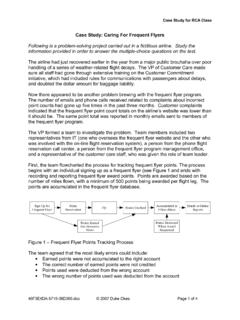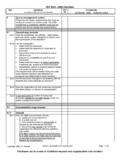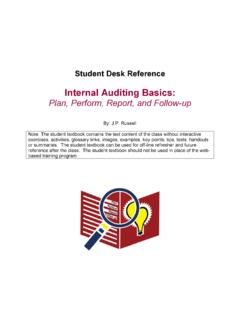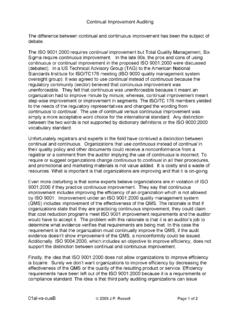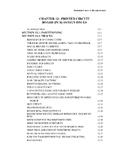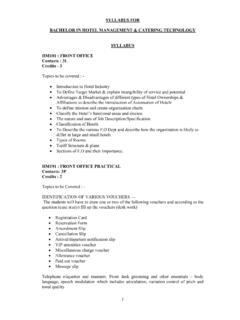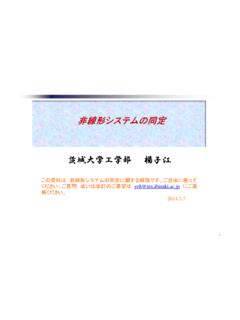Transcription of Process Auditing Techniques - Quality Web Based Training
1 Process Auditing Techniques 2002-2009 JP Russell & Associates Page 1 of 52 Process Auditing Techniques Note: The student textbook/Desk Reference contains the text content of the class without interactive exercises, activities, glossary links, images, examples, key points, tips, tests, handouts or summaries. The student textbook can be used for off-line refresher and future reference after the class. The student textbook should not be used in place of the web- Based Training program. By Russell JP Russell and Associates/ Gulf Breeze, FL 32563 Process Auditing Techniques 2002-2009 JP Russell & Associates Page 2 of 52 Table of Contents Introduction.
2 4 Lesson 1: What is a Process ?.. 6 A. Process 6 B. Control of 9 C. Processes Make the 10 D. Advanced Process and system 11 E. 11 Lesson 2: Organizing the Audit .. 12 A. Process 12 B. Purpose and 13 C. Audit 15 D. Contacting the 16 Lesson 3: Process Audit Preparation 17 A. Audit 17 B. Process Flow Diagramming for the 19 C. Tree 21 D. 23 Lesson 4: Starting the 24 A. Opening 24 B. 26 C. Other meetings during the 27 D. Data Collection 27 Lesson 5: Investigating (Collecting Evidence) .. 27 A. 27 B. Compare Performance to 29 C.
3 30 D. 30 E. 32 Lesson 6: Using PDCA for Control and ACDP for improvement .. 32 A. Control 32 B. Control 32 C. Test 33 D. Interviewing for Control of the 35 E. Test 36 F. Auditing for Control and 38 Lesson 7: Auditing Open-ended Requirements .. 38 A. Types of Open-ended Requirements 38 B. Type I: Open-ended phrases/ 39 C. Type II: Generalized Statements to Control or 40 D. Type III: Unclear or 40 E. Type IV: No Tangibles 41 F. Too Many Open-ended 41 42 Lesson 8: ISO 9001 Auditing .. 42 A. Need for New Auditing 42 Process Auditing Techniques 2002-2009 JP Russell & Associates Page 3 of 52 B.
4 Strategic 42 C. Tactical 43 Conclusion:.. 47 Lesson 9: Analyzing and Reporting .. 47 A. Analyze 47 B. Compliance Audit 48 C. Performance Audit 48 D. System 50 E. The 50 F. Closing 51 G. Ending the Process 52 H. Closing 52 Process Auditing Techniques 2002-2009 JP Russell & Associates Page 4 of 52 Introduction This class is focused on methods and Techniques to conduct Process audits. Internal and external Process audits provide very valuable information to management and oversight organizations. Though Process audit is defined in several texts, there is no book or standard of common conventions or accepted practices.
5 In this class we will follow along the sequence of the diagram (Fig. 1: Process Auditing Detailed Steps). Every attempt has been made to focus on Process audit Techniques and not repeat common system audit practices found in books such as The Quality Audit Handbook. Students of Process Auditing Techniques should already know basic Auditing Techniques such as how to conduct interviews, or develop a checklist. The Techniques presented in this class can be used by auditors who conduct first, second and third party audits to any standard or work instruction.
6 For convenience, ISO 9001 examples are used in the class, but other controls and standards such as FAA, FDA, EPA, OHSA could be used too A lesson on ISO 9001 has been included because of the standard style changes and Quality management system design. The ISO 9001 Quality management system design should be Based on defining, linking, sequencing and measuring processes. Where applicable, Process audit Techniques can be used to evaluate the Quality management system. Process Auditing Techniques 2002-2009 JP Russell & Associates Page 5 of 52 Fig. 1: Detailed Steps Process Auditing Techniques 2002-2009 JP Russell & Associates Page 6 of 52 Lesson 1: What is a Process ?
7 In order to audit a Process , you must first understand what it is. With my background in chemical engineering and business management, I am very familiar with processes. Chemical engineering could more appropriately be called Process engineering. The very first engineering class that I took was called Process Principles. It was considered a difficult class and the demands of the class caused many students to explore alternate career paths. In this beginner class, the students were taught about designing processes, determining duties to be performed, establishing specifications and requirements, and integrating the various units (activities) into a coordinated plan.
8 Additionally, we were told that problems cannot be segregated and each treated individually without consideration of the others1. So the first principle we learned was that Process activities are connected or linked. Secondly, we learned that processes are responsible for the changes that take place within a system. Some call this changing a transformation. The balancing and equilibrium of inputs and outputs is called the Law of Conservation. The Law of Conservation requires that the sum of the inputs equal the sum of the outputs for a given Process .
9 For example the uncut metal plate input equals the fabricated bracket, plus scrap and metal filings. The third principle is that the Law of Conservation applies to a defined Process . For processes to work, inputs and outputs must be in balance. If Process elements are out of balance, the objectives would not be achieved and the Process would not be effective. The output objective demands certain inputs and if you don t have sufficient inputs, the outputs will never be achieved. A fourth principle is that processes can be operated at a set of optimum conditions for best utilization of resources and achievement of objectives.
10 Economics is an important consideration of design and Process operation. Every Process has a set of optimum operating conditions for achieving both economic and performance objectives. Process Principles 1 Activities are linked as sequential steps 2 Change (transformation) takes place 3 The Law of Conservation applies to a defined Process 4 Optimization results in best utilization of resources A. Process Description A Process transforms inputs into outputs. This transformation or change takes place as a series of activities or steps that lead to a desired result (objective).
